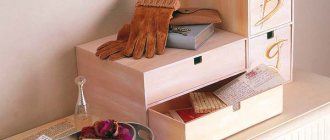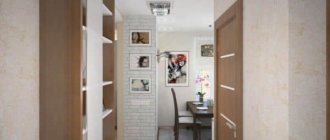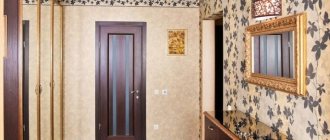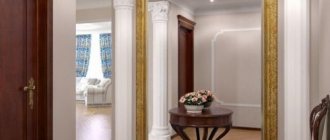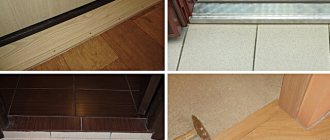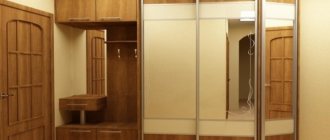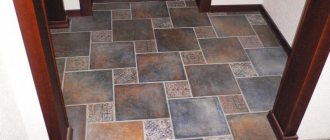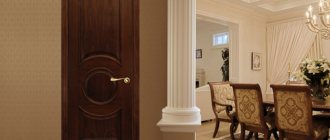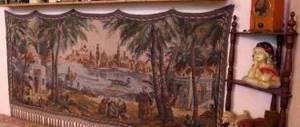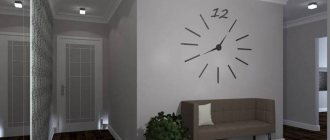Furniture and products made of artificial stone in the interior
Various stone products and furniture are currently quite popular and represent a brutal, but at the same time very sophisticated interior element.
Due to its discreet and sophisticated appearance, a stone sink can complement any design.
Plumbing
Monolithic sanitary ware, such as a bathtub or toilet, is distinguished by excellent tactile sensations during operation and gives the environment a special personality. A stone heated towel rail has increased heat transfer and evenly heats the surface.
The photo shows a toilet with a bidet made of decorative stone in the interior of the bathroom.
Tabletop
A kitchen countertop or base with a washbasin is distinguished not only by its interesting appearance, but also by its good technical qualities, allowing you to achieve excellent results when using it.
Bar counters
They will undoubtedly become an image item and an unusual interior element, which will make the atmosphere much more original and expressive.
The photo shows a kitchen interior with a bar counter made of liquid decorative stone.
Window sill made of decorative stone
It has a truly expensive, stylish look and is in no way inferior to a window sill made of natural material. A huge number of mineral coloring pigments and various additives provide a huge variation of shades and decor.
Accessories
There are a wide variety of accessories, such as table or floor vases, that look very aesthetically pleasing, have natural beauty and, even without additional filling, undoubtedly attract attention, creating interesting installations. Exclusive stone cutting boards always look presentable and fit perfectly into any kitchen space
Also, mirrors framed in the form of decorative stone look no less luxurious and elegant.
Shelves
They can become quite a bright interior detail that can be easily filled with books, figurines, boxes, vases, photo frames and thereby give the room more coziness and homeliness.
Peculiarities
Artificial brick is a specially made decorative tile, the thickness of which does not exceed 2 centimeters. This makes it possible to renovate the apartment without losing space.
In addition, the range of colors, as well as the sizes of this material can be very diverse. In the interior, artificial brick is used to decorate walls in a variety of rooms. They can safely decorate a wall in the hallway, toilet, even in the bedroom. However, decorative brick is most often used in the hallway.
The disadvantages include surface roughness, as well as very low hygroscopicity. This leads to the fact that the material cannot be used in all areas.
Wall under a decorative brick in the hallway: how to make it yourself
Those who are tired of traditional wallpaper and painting have the opportunity to appreciate how decorative bricks look on the wall in the corridor. Gypsum imitation has many advantages over classical masonry. It is much lighter and does not take up the footage of narrow apartment corridors. But it is important to know all the nuances of cladding in order to avoid common mistakes. Decorating the corridor with brick or its imitation with your own hands
What to choose when starting a renovation is a difficult question for those who already have some experience as a designer of their own home.
A universal material available for making and finishing with your own hands - bricks for the wall in the corridor. Using catalogs of building materials, it is possible to evaluate a wide variety of textures and shades of imitation brickwork. This is a practical cladding that can be easily integrated into a modern interior. It is undesirable to use bricks with different textures in the same room; it looks tasteless. When there is a desire to invest within a modest budget, a brick wall in the hallway can be made independently, using a gypsum or cement mixture. The finished fragments are applied to a layer of starting plaster using construction adhesive or cement mortar. Once complete, the individual blocks can be painted or varnished. If you get tired of the coating, after a while it can be easily repainted in a different color - experiments are quite appropriate. When you want to invest within a modest budget, you can create a brick wall in the hallway yourself. Features of use in interior decoration
The use of imitation brickwork has several options:
- Solid wall (end or accent).
- Strengthening corners.
- Fragmentary finishing - niches, arches, “unfinished” masonry.
- A brick wall in the hallway as an addition to other decor (wall painting, tiled mosaic, fresco, partition between columns or pilasters).
- Separate panels and inserts.
- Imitation of “bare” masonry with partial plaster coating.
When choosing a wall shade to match decorative brick in a hallway or corridor, it is important to ensure that the texture and color match the natural analogue. When choosing a wall shade to match decorative brick in a hallway or corridor, it is important to ensure that the texture and color match the natural analogue. Decorative stone in the interior of the hallway
Modern decoration is replacing outdated wallpaper and painting. Among the most relevant building materials for small hallways, decorative analogues of brick and stone masonry are usually mentioned. The material fits perfectly into most stylistic decisions:
- Eastern ethnics;
- Minimalism;
- Eco style;
- Loft;
- High tech;
- Country and Provence.
When purchasing a large batch of facing stone, it is important to make sure that all packages are from the same batch. If 1-2 boxes have different markings, the fragments may differ in density, texture and shade. It will be difficult to exchange them even with a receipt. When combining elements of different shades, craftsmen recommend making a preliminary layout on the floor. Before making a brick wall in the corridor, it is advisable to lay out fragments of about 1 square meter (or 3-4 rows in height). This is a real opportunity to pre-assess whether light and dark blocks are evenly distributed. Before making a brick wall in the corridor, it is advisable to lay out fragments of about 1 square meter. Advantages of brick finishing in hallways
Attractive brick wall decoration in the corridor, on the staircase and in the hallway has a lot of advantages, among them:
- Aesthetics adaptable to most styles;
- Organic combination with other wall, ceiling and floor finishes;
- The material’s lower density than stone or brick means it’s light weight (ideal for shrinking cottages and old buildings on unstable soils);
- Possibility of fragmentary replacement of damaged elements;
- The small thickness of the false brick masonry does not affect the passage in a narrow interior space;
- Resistance to mechanical damage - ideal coating for hallways and corridors in apartments of families with pets;
- Excellent design, wide range of shades and textures at low cost of cladding.
Carefully laid decorative bricks on the wall in the corridor are practically free of flaws. Requires special attention when laying, cutting and transporting, so as not to spoil some of the crumbling fragments. Ideal coating for hallways and corridors in apartments of families with pets. Main types of imitation brick for interior decoration
Excellent design and demand for the material have led to an expansion of the range of coatings that resemble a real brick wall.
Among them are many high-tech proposals. You should read more about how to make brick walls in a hallway using other materials. Excellent design and the demand for the material have led to an expansion of the range of coatings that resemble a real brick wall. Imitation of a brick wall made of plaster
Among the wide variety of decorative plaster, there are also proposals based on sand, stone chips, and other natural inclusions.
This base can be used to cover a wall, making prints in a special form, meter by meter. This base can be used to cover a wall, making prints in a special form. “Brick” wallpaper
Paper and vinyl wallpaper with a “brick” pattern came into fashion about 25 years ago, but has not lost its relevance.
Their design is regularly updated, and they will always be in demand, since not everyone can afford complex cladding. But everyone can do their own wallpapering of walls. There are more interesting options. For example, photo wallpaper depicting the ruins of a castle with stone and brick (another theme). They are printed on a textured base reminiscent of natural stone, cut into blocks. Wallpaper will always be in demand, since not everyone can afford complex cladding. Imitation of a brick wall made of polystyrene foam.
Textured surfaces are often printed on the cheapest base.
Their design is not inferior to more expensive modern materials, especially after painting or varnishing. The most affordable is considered to be imitation masonry on foam blocks. It looks quite decent, but it won’t last long, especially if there are animals in the house that are used to sharpening their claws on different surfaces. The most affordable is considered to be imitation masonry on foam blocks. Combining artificial stone with wallpaper
There are other types of imitation, for example, a brick wall in the interior of a hallway made of agglomerate. This is stone chips poured into polymer - photo. The catalogs also have a large selection of panel and roll materials:
- Paintable glass wallpaper with the texture of stone and sand-lime brick;
- Solid sheets of glass-vibroconcrete;
- Polymer panels with imitation masonry.
When choosing innovative coatings, it is worth considering all the nuances, including the possibility of self-cladding. The second important factor is the harmonious combination of synthetic coating with natural analogues and other types of finishes. You should not combine real brick with wallpaper of a similar design. A textured wall with smooth paintable wallpaper or bark beetle plaster will look most organic. When choosing innovative coatings, it is worth considering all the nuances, including the possibility of self-cladding. Advantages and disadvantages of materials
Modern synthetic materials have a number of positive qualities:
- Available technologies for making homemade facing bricks - filling ready-made molds made of silicone and polyurethane with a solution;
- The synthetic analogue is much lighter in weight.
Homemade bricks made from plaster or concrete are easier to lay than natural stone or brickwork. It is impossible not to mention some other disadvantages:
- The reliability and durability of the imitation is much lower than that of real masonry;
- Individual fragments may fall off due to rough mechanical impact;
- The integrity of crumbled plaster decor is difficult to restore after damage to part of the wall.
When making gypsum bricks for the wall in the corridor yourself, it is recommended to make a small supply. The same wish applies to decorative painting and protective varnish coating. Homemade bricks made from plaster or concrete are easier to lay than natural stone or brickwork. How to paint false bricks
Imitation of masonry can be made in a single color - white, light brown or beige. The most natural look will be imitation of silicate, clinker or red brick. Using the same method, you can update a boring monochromatic plaster coating with imitation bricks or “wild stone”. If the artificial masonry looks somehow “boring”, you can manually lighten or darken individual blocks. The most attractive look is the combination of fragments that are more different in saturation in one color scheme - milky, terracotta, sand or rocky gray. You can add pigment to the water-based whitewash for bricks on the corridor wall. The surface can be slightly shaded with a sprayer with a bronze or metallic effect. Depending on the desired effect, coloring is carried out using different devices:
- Spray bottle;
- Spray paint;
- Paint brush;
- Whitewash brush;
- Porous sponge;
- Roller with decorative attachments.
To treat a solid wall, it is recommended to treat it with a primer or special impregnation. Finish coating – acrylic, silicate, any interior paint recommended for decorative plaster (same base). The most natural look will be imitation of silicate, clinker or red brick. The main disadvantages of decorating a corridor with brick
A brick wall in a narrow corridor is not always appropriate.
Too voluminous decor of “bare” walls, imitating the absence of plaster, is not suitable for noble interiors - with expensive cladding and interior doors with inserts. You need to be especially careful when visually expanding a narrow corridor with mirrors. A reflective wall will visually “double” the exposed brick, creating the appearance of “overhang” on both sides. A brick wall in a narrow corridor is not always appropriate. What is forgotten when decorating a corridor with false brick?
A neatly laid wall made of imitation brick in the interior of the hallway looks much more impressive than most other design solutions.
However, failure to follow technological recommendations when making a homemade “brick” from gypsum and cement (without compacting the mass) makes it fragile. Minor defects in walls and partitions will not be visible after decorating with false bricks. However, this does not eliminate the need to pre-level the vertical surfaces so that the material fits perfectly on the wall. If there is a clear lack of material, the seams need to be hemmed or laid in unfinished rows. When purchasing cladding, keep in mind that packaging and costs are calculated by square meters. When adjusting during installation, there is a large overexpenditure of fragments, so add another 15-20% for trimming. Porous textured material (gypsum, concrete) requires impregnation or protective coating with colorless varnish. This will make the faux brick wall in the hallway more uniform, making the surface easier to maintain. Porous textured material (gypsum, concrete) requires impregnation or protective coating with colorless varnish. During renovation, every owner of a cottage or apartment wants to receive inexpensive and practical coverage. Durability and aesthetics are important characteristics of modern facing materials. These are the properties that decorative brick walls in the corridor and hallway have. It is easy to make artificial “wild stone” and thin false brick with your own hands and lay it on the wall yourself. The nobility of the texture, imitating natural analogues, is the dream of thrifty owners. Video: DIY brick wall
Source:
unique templates and modules for dle
Coloring option
In bulk
It is considered the most practical and best way. In this case, coloring pigments in powder form, which are used for concrete, are added directly to the gypsum solution. Thus, you receive a product that is painted from the inside. When cutting or chipping, you will not see the white base.
A beige or yellow solution is best, and in polyurethane form, parts of the stones can be painted with liquid pigments using a brush.
For this:
- take ½ tsp. color (pigment);
- add 200 ml of water;
- add 200 ml of any acrylic primer.
When the stone has set, remove it from the mold and dry it, and after laying it on the surface, apply a matte water-based varnish to it.
This option for painting decorative gypsum stone is the most effective and almost all manufacturers use it. That’s why we can see these kinds of products in stores. The disadvantage of this method is the rough and unnatural painting, which can be observed at close range.
By making gypsum artificial stone yourself, you have the opportunity to work on naturalness by carefully painting parts of the stones in the mold. Of course, no one will do this on an industrial scale, otherwise the price will increase significantly.
Below we will propose another painting technology that will help make a product from gypsum tiles that is more similar to natural stone. You will learn how to paint artificial stone so that it has the same natural veining and color scheme as natural stone.
Surface
Prepare:
- water-based (coloring pigment);
- water;
- spray or brush.
The instructions are simple - you need:
- add a coloring pigment to the water, you can even add several at once;
- dip a brush into the solution;
- saturate gypsum tiles with it.
Artificial gypsum stone has unique properties of developing shades that are similar to natural ones due to the absorption of tinted water.
In order to give gypsum stone the desired shade and color, you do not need to have an artistic education. Dip the brush into the colored water and paint the stone as you see fit.
Then you can tint some with a dark solution consisting of color pigment and water. You shouldn’t think too much about the palette, since each gypsum tile, even with the same texture, will absorb the solution differently, which will allow you to create an individual pattern each time.
You can also use any sprayers for work, for example:
- spray gun;
- sprayer for glass cleaning products.
Pour paint diluted with water-based tinting paste into a container and spray it onto the gypsum tiles. It is better to use several of these sprayers with different colors in your work so that you can treat different places on the stone. Then the painting process will be better and faster.
The advantage of painting yourself
- The store offers artificial stone in standard colors and with obvious artificial coloring. It does not have natural colored veins, like natural ones.
- You can purchase products in white or plain beige, glue them to the walls, and then paint them on the spot with water and coloring pigments diluted in it. This method makes masonry much more natural. (See also article.)
- Once the plaster stone has dried and become faded and pale in appearance, open it with any silky matte or matte varnish. This way you can restore the color saturation of the product, strengthen and protect its surface.
- If you want to achieve a “wet” effect on artificial stone, use varnishes, but be aware that this will slightly reduce the naturalness of the material.
Basic principles of laying finishing material
If you have chosen clinker or finishing bricks to decorate your hallway, you should understand that such material is difficult to fit into the interior of the room. Thanks to some tricks, it can be combined with any style solution. As a result, the interior will become more elegant and unique. The installation technology is carried out in the following sequence:
- First you need to level the surface on which the finishing material will be attached. This will significantly simplify finishing work and ensure high-quality installation of stone. During the work process, there may be a need to cut stone. To do this, use special tools or a regular grinder;
- To attach the finishing material, use a special adhesive solution, which can be found in almost any hardware store. It is worth considering that to install a certain stone you need appropriate glue. In some cases, it may be necessary to prime the surface;
- The finishing material is laid according to the principle of brickwork: the seams of one row should be located in the middle of the bricks of adjacent rows. Finishing work should begin from the corner;
- As soon as the solution has set, its excess is removed from the seams. It should be understood that some materials, such as slate or sandstone, are laid using a seamless method;
- After the adhesive solution has completely hardened, the finishing coating should be cleaned of all contaminants. It may take several days to dry completely. To do this, you can use a regular damp cloth. At the same time, do not press so as not to damage the coating;
- To protect the masonry from fungus, it is treated with an antifungal solution. Of course, some brick models undergo such treatment at the production stage;
- At the final stage, experts recommend covering the surface with a special water-based varnish. This will protect it from various contaminations and damage. The glossy surface, opened with varnish, will reflect light rays, which will visually increase the space of the room;
Related article: Ideas for a small studio apartment - which curtains increase the space
Laying decorative bricks
As you can see, decorating a hallway with decorative stone is a very simple process. Of course, in order to perform the work efficiently, you must have certain knowledge and skills. But the main thing is to choose the right stone so that it fits into the interior of the hallway as naturally as possible. With the right approach to solving this problem, you can easily choose a finish that will color the entire room.
Finishing
When decorating a hallway with decorative bricks, you need to determine the area of the surface to be decorated. Then, having calculated the required amount of material and adding to it an additional 10-15% of the required amount, purchase raw materials. The reserve takes into account the loss of material during the fitting process, cutting or in case of accidental damage. In order not to take extra bricks, you can outline the boundaries of the masonry and prepare a diagram for the arrangement of fragments (especially important for bricks of different shapes and sizes). To simplify the task, the placement can be done on the floor, not forgetting to take into account the topography of the wall and the distance between the seams (the method allows you to adjust the laying order if the fragments do not match).
Having decided on the quantity, they prepare the wall, which involves the process of removing old paint, wallpaper and leveling the surface. For reliable fixation, use a deep penetration primer. You need to start installing the bricks from the corner: this eliminates the need to adjust the elements at the junction of the walls, which is problematic to do. When working, you should use a special glue for the specific coating chosen. The masonry is carried out from the bottom up in rows using the following technology: the joining seams between the bricks of the first row are placed in the center of the bricks of the next row. When laying materials that include shale and sandstone, seamless technology is used.
After the glue has dried, you need to wipe the surface with a damp, but not wet, cloth (this makes it easier to remove dust and other contaminants). It usually takes several days for the solution to dry completely. If antifungal treatment was not applied during the production of bricks, it is necessary to independently cover the laid surface with a special solution. This is a water-based varnish composition that protects the surface from contamination and accidental mechanical influences. It is applied after drying, gives the wall a glossy shine and visually expands the space.
As a budget finishing option, you can cladding one wall, on the surface of which it is better to highlight an arch, mirror or niche. You won’t need many bricks for such a renovation, and the decoration effect will pleasantly surprise you. For better design, you should purchase lightweight, wear-resistant materials. When choosing the main tone of the walls, you should not choose too dark shades, because often there is no natural light in the corridors. Considering the purpose and specifics of the corridors, it is preferable to use easily washable materials.
After completion of the work, it is recommended to cover the surface with spraying, the color of which will be a couple of tones darker than the shade of the artificial stone. This will make the surface more expressive. An interesting technique would be to highlight the outline of the masonry with bronze or dark gold paint. An additional coating of acrylic varnish will help make the brickwork glossy, and well-placed lighting will emphasize the aesthetics of artificial stones and make the corridor stylish and solid.
Advantages of brick finishing hallways
Brickwork for decorating the interior of the hallway is the most popular. Ideal for this option would be darker colors, on which dirt is less noticeable. This option for decorating the interior of the hallway will allow you to use tiles that have an aged look. It should have scuffs and cracks.
In certain cases, lining the hallway walls with brick will not seem excessive. It is often appropriate to finish only one wall, highlighting an arch, a niche for a mirror or other element.
Brick is a building material that has always been and will always be relevant. A product that is durable, beautiful and reliable, attaches to any surface. It is light, but not fragile, and does not crumble during processing. The material is resistant to temperature changes, so there is no risk of cracks forming on the wall. Brick, unlike stone, has a specially treated surface, which simplifies installation work.
Decorating the hallway with decorative brick has a number of advantages:
- the surface is easy to clean;
- the wall has high thermal insulation properties;
- the finish can be of any color;
- A wide range of materials makes it possible to cover surfaces of varying degrees of curvature.
If you line the hallway walls using decorative bricks in the interior, you can save yourself from the need to make regular repairs in a short period of time. Brick is an environmentally friendly and durable material, so fungus or mold will not appear on a brick wall.
If you plan to decorate the hallway, you can decorate not only the entire wall, but also its fragments. A delicate approach is required to create a durable brick surface. A small hallway does not require the creation of monumental interior design. The hallway should not have massive walls, which are ideal for cellars or dungeons. Using a fragmentary method of decoration, we can distinguish:
- doorways;
- viewing angles;
- part of a small wall or its entire surface.
The latter option makes renovations in the hallway not too expensive, since fewer bricks are required for fragmentary wall finishing.
Tiles, facing and decorative bricks
Decorating a hallway with stone, tile or brick is a rather complex process. The approach to solving this problem must be precise, since care is required both in choosing the material and in the process of performing the work. The material used is not only decorative brick, but also tiles, which are its imitation.
The tile is called clinker. A certain technology is used for its installation. The advantage of this material lies in its relatively light weight and small thickness. Tiles are used when carrying out finishing work, the result of which is not associated with a decrease in the effective area of the hallway.
Clinker tiles are perfect for finishing.
Using facing clinker bricks to decorate a hallway is expensive, since the cost of this material is higher than others. The high cost of the product is due to its high performance parameters and quality. Its surface is quite smooth, and the color scheme is original. This material is characterized by a high level of density and strength. The resistance of facing clinker bricks to high temperatures allows it to be used for finishing fireplaces.
Decorative brick is formed by hand. To make it, a mixture prepared using cement and gypsum is used. The technical parameters of this product resemble the properties of ordinary bricks. The difference between the material and others is its increased fragility. The manual method of manufacturing this material allows you to give it a rough surface with a relief pattern. The product is ideal for use in places where there is no heavy load, and where frequent washing of the surface with water and chemicals dissolved in it is not required.
Room design
To make the design of any interior look beautiful and aesthetically pleasing, you need to choose the right areas and shades of the product. You should purchase something that will be in harmony with the palette of design and furniture.
Living room
It is necessary to pay extreme attention to the design of this room, since it is where various special events, family gatherings and meetings of friends are most often held. Modern interiors allow you to use an accent in the form of a brick wall, making the room more cozy and atmospheric. Masonry is a wonderful decorative element, so it is not necessary to decorate it in any way. If you still want to add something, you can place some beautiful photographs or posters on the masonry. They will look harmonious and will not clutter the room.
For the living room you can choose any shade of the product
It is important that it is successfully combined with the design. Some decorate one wall, while others decorate separate areas.
Both options look decent. A fireplace or stove made of brick looks incredibly attractive and interesting, as well as a niche located in the wall, which will create a special, pleasant and cozy environment. An ideal option for a living room combined with a kitchen is a medium-sized brick wall, which will help separate the zones.
Bedroom
Brick elements in the design look extremely warm, so quite often this element is used when decorating a bedroom. Brick combines well with a variety of facing materials. It is often used to decorate the wall at the head of beds or the one on which the TV panel is located. If the room is too narrow, and the back of the bed is located against a long wall, it is this surface that is decorated with interior brick. This allows you to make the room wider, as the wall moves away visually.
Hallway
If the corridor is small, decorating with light decorative material, the surface of which is glossy, is suitable. This option allows you to make the room larger and more spacious. Most often, this solution is used for Scandinavian style or minimalism. You can make a fragmentary finish with red brick, decorating the corners, areas at the joints of surfaces, arch areas and the entrance door opening. If the room is large, masonry can help with zoning.
Kitchen
Even if the room is extremely large, you should not use too much brick in its design, as this can ruin the interior. It is better to make brickwork a connecting link between different types of finishes. It is worth correctly determining the wall on which the material will be placed: the masonry should be on the surface on which natural light falls. If you want to use red brick, it is better to use sources of additional lighting, since such elements will absorb light.
Bathroom and toilet
The microclimate in the bathroom and toilet is specific, so interior brick is not a very good option for these rooms. If it is still used, the elements should be treated with a special agent that will rid the apartment owner of mold. It is also better to use an antibacterial composition. The rough surface of the brickwork and snow-white plumbing is a combination that looks extremely attractive. In most cases, surfaces are decorated using plastic panels or tiles that imitate brick.
Balcony
Decorating a loggia with decorative bricks is a good idea, because it looks harmonious and beautiful. If the balcony is small, you should choose thinner elements. With this decoration you can create a cozy and pleasant room for rest and relaxation. Both light and dark bricks are used. If desired, you can decorate the area around the doorway with gray or aged brick. Both options look very interesting and modern.
Peculiarities
Not every apartment can accommodate an additional brick row - buildings these days are built from metal and concrete, wood and frame structures have become the norm. Not every structure can withstand heavy brickwork. But you shouldn’t give up such a spectacular design option. An alternative could be gypsum tiles designed to look like brick.
It, like any other material, has certain pros and cons, knowledge of which will help you make the right choice.
Advantages:
- Safety. Gypsum is a material of natural origin, therefore, products based on it are environmentally friendly.
- Durability. Compared to many other finishing options, it has greater strength that is maintained throughout its service life. Often used in places most susceptible to abrasion and mechanical stress.
- Thermal insulation. Due to its low thermal conductivity, it retains heat inside the room, preventing the cold from penetrating outside. A wall covered with such material will never freeze.
- Noise insulation. The density of the material is high, sound permeability is low, and accordingly, noise penetration is minimized.
- Fire resistance. Withstands direct flame combustion temperatures and can be used for direct lining of stoves and fireplaces. When heated, it does not emit any hazardous substances.
- Maintaining a comfortable indoor microclimate. Absorbs excess moisture from the air, releases it in case of excessive dryness, and evens out the temperature of the surrounding space.
- The ability to create a realistic texture, place accents, and emphasize the dynamism of the interior.
- Weight. Gluing can be carried out on any wall without reinforcement using almost any adhesive, and does not carry a global load on the floors.
- Ease of installation and processing. You can start work with absolutely no experience.
- There is no need to purchase additional equipment or special materials.
- Price. The price/quality ratio is ideal. The price of the material is low, moreover, it is possible to manufacture it yourself.
Flaws:
- More suitable for interior than exterior work.
- Excessive hygroscopicity is a contraindication to placing the material in street decoration; however, today the production of gypsum-cement boards has been launched, which is quite suitable for exterior finishing.
- Increased fragility. This indicator can be reduced by adding special substances at the manufacturing stage and treating the surface with them after installation.
- Difficulty in care. An untreated gypsum surface can accumulate dust.
- When tiles are placed in a room exposed to high humidity, they must be treated with additional protective and water-repellent solutions.
Types of “brick” wallpaper for the hallway
Vinyl materials are the most optimal option for decorating a corridor. The photo shows an option for decorating the hallway with brick-look wallpaper.
Their application does not require any special skills; the resulting surfaces have excellent aesthetic and performance characteristics.
Wallpaper becomes a metaphor for dishonesty and pretense, for the ephemeral rather than the safe and lasting, for valuing appearance over substance. It is not surprising that the debate surrounding the morality of ornament - especially on wallpaper - came to prominence when the invention of machine printing and the abolition of excise duty on printed paper brought wallpaper into fairly modest households. Therefore, it was important to distinguish between chaste, “honest” and correct design, on the one hand, and cheap, tasteless excesses of popular taste, on the other.
Voysey often preferred to use other types of wallpaper or nothing at all. It is often associated with cleanliness and comfort, and has become a kind of shorthand symbol for domestic and domestic life, easily co-opted by writers, artists and advertisers. In her story “The Yellow Wallpaper,” Charlotte Perkins-Gilman deliberately used wallpaper to symbolize the claustrophobia and oppressive control that a creative woman could experience within the confines of her home and family.
Attention! Non-woven fabrics “brick-like” are used much less frequently in the corridor only because they have a high cost.
Among the positive parameters of these materials, we note their increased resistance to the negative effects of ultraviolet radiation. They are environmentally friendly and have a long service life. Such wallpaper (pictured) is appropriate in the corridor; it can withstand several repaintings.
In recent years, artists wishing to recreate or explore aspects of home and personality in the context of an art gallery or museum often choose to design and make wallpaper for its inherent associations with inner life. While furniture and textiles often survive and are passed on from one generation to the next, wallpaper is often damaged, completely covered up, or removed. This is typically the simplest and, relatively speaking, cheapest aspect of interior design, and therefore the least likely to survive.
This is sad because wallpaper is the most eloquent embodiment of changing fashions, a clear indication of an individual's taste and the fundamental basis of any new decorating scheme. Serious academic study of wallpaper, and the integration of the collection and preservation of historical works, did not begin in earnest until the early 20th century. Inevitably, museum collections and documents that survive in situ tend to be the best of their kind, and therefore in many ways the least typical.
Paper wallpaper in the hallway is not the best solution. Despite their low cost, excellent appearance, reasonable cost, and high environmental friendliness, they do not have a long service life.
Paper wallpaper is thin, so it is not able to hide all the defects that are on the walls in the corridor.
A stone wall is a stone wall made of only natural stones. Unlike man-made brickwork, a natural stone wall exudes a rustic and romantic flair. Unique stone fixtures transform each apartment into a cozy and warm home.
Our natural stone wallpaper can be found in many different colors and stone sizes. Wallpaper made from slate optics has a very interesting pattern. The densely packed stones form an almost “filigree” stone wall. Our stone slabs in slate stone optics are available in lift, paper wallpaper and as self-adhesive wallpaper for wall and door. You may see wallpaper in a broken appearance on bulky, large rocks. Large heavy cracks formed into an impressive stone wall look impressive on any wall.
Advice! To prevent brick-like paper wallpaper from spoiling the overall impression of the hallway, you must first thoroughly prepare the walls (priming, sanding all walls decorated with such wallpaper).
The main disadvantages of “brick-like” paper wallpaper in the hallway can be considered their instability to mechanical damage. In addition, such brick-like wallpaper in the hallway (photo below) quickly loses its original aesthetic characteristics due to the negative effects of sunlight.
What wallpaper is suitable?
Naturally shaped and artistically designed rock formations are high-resolution photographs of real rock walls.
Veneer wallpaper can be removed on all networks. If you need a wallpaper change, you can easily remove the wallpaper, unlike paper wallpaper, without extensive preparation. The back is covered with a blue layer and prevents the wall from passing through. So you get a large photo paper for less than 100 euros. As the name suggests, self-adhesive wallpaper should be applied to the wall without glue. The motifs are glued to thin self-adhesive foil and can be glued directly to the wall. You don't need a lot of knowledge to get self-adhesive photo wallpaper on your wall. However, you must work in pairs. This makes the job easier. Self-adhesive wallpaper can also be cleaned without leaving any residue. Self-adhesive photo tapestries shimmer with a slightly silky matte compared to both wallpaper and purple wallpaper.
Imitation of such wallpaper in the corridor (hallway) gives the opportunity to create a stylization of an ancient atmosphere in design, to recreate the spirit of the Middle Ages, without wasting significant time and material resources.
Advice! It is better to choose “brick” wallpaper in the hallway in light shades, so that you can (if desired) paint it in the desired shade.
Now we need urgent help for a good restoration of the wall, which is not all being formed again. You can find possible mute-. Wall construction. In the case of internal demarcations, which are physically complex and more destructive than exhalations, always applies to all component designs: cavity-free, capillary-active, non-diffusion.
So: everything is also a “back vented” sink with an internal wall, before the original masonry. Delete all existing ones. if it is needed. There are also no vapor barriers or brakes or other folio cleaners. Otherwise you will create exactly the same damage that just gave you the form.
The photo shows the renovation of the hallway with brick wallpaper.
Types of decorative finishing stone
Today there are three types of decorative artificial stone used for interior decoration:
- cement-based;
- gypsum based;
- agglomerate.
These products are very similar in appearance to natural stone, only they weigh much less (from 14 kg/m² to 50 kg/m²). The cost is also much lower (compared to natural), especially if the manufacturer is Russian or Belarusian. The advantages include easier installation - only the front part is textured, the other three are more reminiscent of tiles or bricks.
Actually, there is another type of artificial finishing stone - clinker tiles, imitating brickwork of various types. It is made from clay using almost brick technology - fired in a kiln and glazed. The difference in thickness is 1-3 cm. This type of finishing is good in many modern interiors - from high-tech to loft.
Samples of clinker tiles to imitate brickwork
Gypsum based
Gypsum finishing stone is the most inexpensive of this type of materials. Its second advantage is that it is the lightest. This is what is used when installing on drywall, since it simply cannot withstand heavy loads. Disadvantages - it is quite fragile, hygroscopic, and can collapse if wet. Decorating a hallway with decorative stone based on gypsum is possible only if, after installation, it is treated with a special protective impregnation or acrylic-based varnish.
The format of gypsum tiles can be any - a very plastic solution allows you to get any surface and shape
Light shades in hallways do not “pressure” and do not add heaviness
Heterogeneous color adds extra volume and charm
Gypsum decorative stone in combination with a gypsum panel in the corridor - oriental style
Decorative stone stands out especially against the background of smooth walls
Different color options of one collection
Cement based
A strong and durable finishing stone is obtained from a gypsum-sand mixture. It can be washed, even with a brush and liquid detergent. Its disadvantages:
- Hard to cut. You will need a grinder with a diamond blade to reduce dust, you can wet the tiles.
- Heavy weight. This is when compared with a gypsum analogue, and compared to natural, the weight is more than half as low.
- Higher price. In the production of cement decorative stone, high-quality cement is used, and it costs a decent amount. In addition, the production technology affects the price - cement takes longer to gain the required strength (28 days), and until this moment the molded tiles must be stored somewhere, and under certain conditions (at a temperature of about 20°C and sufficient humidity of 40-50%). This means that significant areas for storage space are required, and this means additional costs.
All these shortcomings are compensated by durability and ease of maintenance, so this is one of the most common decorative stones for interior and exterior decoration.
Combination of decorative stone and wallpaper in the corridor
This type of decoration in the hallway is convenient in terms of cleaning
You can completely line the walls in the hallway with decorative cobblestones
Interesting color
Light gray is just right for a small hallway
If you decide to make such walls, the lighting should be bright
An excellent option for decorating a fashionable loft style
Artificial agglomerate stone
This type of decorative finishing stone has appeared recently. It consists of natural rocks crushed to crumbs - marble, granite, quartzite - to which polymer resins or cement are added. To obtain bright colors, a coloring pigment is added. This decorative stone looks great - interspersed with natural fragments, reflections on the edges of the crumbs... It looks really good, suitable for finishing work indoors.
Granite agglomerate
Samples on the stand of one of the class=”aligncenter” width=”600″ height=”437″[/img]There can be many color options: quartz agglomerate
Painting methods
When choosing a collection made from gypsum or cement, pay attention to the method of painting. Pigment can be added to the solution, and then the entire tile will be the same color
Tints are then applied to its front surface, which give the surface a more natural look. With this technology, even when chipped, the difference will be unnoticeable, since the shades are close.
In another embodiment, the pigment is applied only to the surface. Then, if it is chipped or needs to be cut, the color will be very different.
Decorative brick for interior decoration
Over the past few years, the popularity of using brick for interior decoration has increased significantly. This fashionable and prestigious material allows you to create a durable and beautiful coating. It has certain advantages, such as:
- practicality in the interior;
- aesthetic appearance;
- ease of care;
- high strength.
The bricks used for interior decoration are completely different from the real decorative bricks used for cladding facades and other structures. The fact is that they are light in weight. Thanks to this, when using it, there is no need to think about the fact that additional load is created on the foundation. You can use it to create an imitation of brickwork. Since it is light in weight, it can be used in unlimited quantities.
There is a large selection of this finishing material on the market, both in shade and texture. This allows everyone to choose a material that fits perfectly into the interior of the hallway. Properly selected material will allow you to express the feelings and character of the owner of the house.
As for the shade itself, it is best to use light-colored stone to decorate the hallway. This is explained by the fact that the hallway is often small in size. The use of such material will visually increase the space. Since brick has a glossy surface, it would be advisable to use good lighting, which will also visually increase the area of the room. Decorative stone can be used to cover the entire wall or its individual fragments. So, for example, you can trim a doorway or niche. This stone is especially often used for finishing areas that get dirty quickly. This will allow you to preserve the original appearance and beauty of the entire finishing coating for a long time.
Decorative brick in the living room interior
Let's answer two important questions first. Does brick always look good in a living room? Of course not! Can faux brick be used in living room decoration? Of course yes!
However, you yourself understand this perfectly well. It was said earlier that the bedroom should be cozy. Sure, but the living room should be more than just cozy. It should be the center of comfort in your home.
After all, the living room is where you spend most of your time in the house. A place where you relax, where you meet friends.
Speaking of a living room that has a brick wall, we can say that this wall becomes the center of your home. The wall that you get should not deny the entire decor of the house and contrast itself with all other design elements.
Maximalism in design is not for everyone. Before using brick in the interior of the living room as in the photo, think three times about the need for such a decision
When planning to use such material, always remember that in an apartment or house there is a room that is the center of your home. Therefore, it should be organized in the same style as the rest of the house. All rooms in your home should create a single whole with this center.
Well-designed brick living room interior. The almost pastel colors of the masonry are in perfect harmony with the overall color scheme of the entire furnishings and its details.
Brick tiles in the living room can make an accent wall, and spotlights will add an atmosphere of mystery and mystery
Real brick from the old masters can also be an excellent solution for adding style to the living room
Is it worth decorating such a wall in the living room?
In itself, such a design element is already an attractive element, but minor additions can positively enhance the effect. But under no circumstances should you overdo it with the amount of additional decor. Extra redundant photos, pictures - all this will lead to the opposite effect.
Attach two or three family photos from a long trip or an interesting painting to this wall. Also, if possible, install a fireplace near the wall. It's a really good idea to have a simple electric fireplace and a few directional spotlights. Family comfort and an atmosphere of calm and tranquility are guaranteed to you.
This is no longer just a few rows of laid tiles. This brick living room with a fireplace really takes us back to the old days and creates a feeling of comfort and warmth.
Natural, familiar colors are a frequent choice of designers
Style solutions
The loft allows the use of imitation brickwork; with the help of such finishing materials you can create a real creative workshop in your hallway.
The photo shows a design option for the corridor, taking into account all the design subtleties.
This allows for insulation of peripheral walls regardless of the masonry technique: brick, cinder block or concrete. Installation must be carried out on sound walls, free from roughness, plumb more than 2 cm, dust, grease or oil. The area at the foot of the supporting wall is cleared before implementation. To achieve perfect wall sealing, the top and bottom of the liner must be completely sealed to avoid air leakage at the back of the liner. The joints will also be made at the junction with the ceiling and perimeter frames.
This technique of insulating walls from the interior brings... It's just when you can no longer tell the difference whether it's real or an imitation. Installing this type of wallpaper is easy and you can do it yourself. While in your room or any room in your home, they can make you feel like you are somewhere else while at home, such as by imitating nature and vegetation. you have a choice, you want to have plants in your home, but you can’t afford it for one reason or another?
Fans of the Gothic style will be able to use similar wall finishing materials to turn the corridor into a real medieval castle. In order to further emphasize the luxury of the interior, you can choose materials to match white brick.
In this case, your problem is solved, because there is a trompe l'oeil wallpaper - an eye that imitates plants, flowers or even an entire landscape of forests, meadows and all types of vegetation. Choosing this nature-oriented wallpaper ensures that you are committed to plant maintenance!
If you're more of a beach lover, there are wallpapers that offer paradisiacal views of the emerald sea and fine sand. Every time you enter your room, you can say goodbye to stress because you will have the opportunity to see this magnificent panorama of the beach to make you dream.
The photo shows an option for decorating a corridor using brick-like materials. When selecting such fabrics, it is necessary to approach the selection of colors with special care. It is important to consider the lighting of the room, the size of the corridor, as well as the finishing option chosen for the entire living space.
Walls with materials of your choice
There is no need to get your hands dirty by touching bricks or even a bag of cement. To achieve this result, the use of wallpaper can be eye-catching. Do you want to have a New York loft style room with white brick walls or plain bricks, you can choose wallpaper in this model. You can also choose from a variety of available materials such as wood, metal and many more.
Decoration in all forms
But even in this case they play their role of illusion. We are talking here about wallpapers that imitate, for example, the skin of different animals. You can find many options such as leopard, zebra, python, crocodile, snake or any other animal of your choice. Do you prefer modern or classic design? And why not industrial style? In this article we will introduce you to brick wallpaper that will make your interior modern and original.
In the photo you see an option for choosing the right colors for the hallway.
The basic rule for decorating this room is to combine brick-like materials with other types of trellises. Coverings with an uneven surface will have an interesting look; they will give the interior additional charm.
It is not necessary to glue all the walls of the corridor with brick-like finishing materials; it is quite possible to limit yourself to only decorating one wall.
“Brickwork” is appropriate for decorating arches, doorways, window frames, loggias, and balconies. Imitation brick is used to decorate an accent wall.
Advice! The optimal choice would be to decorate the wall located opposite the entrance with brick-like materials.
Interesting tips from professional designers are presented in the video fragment
The photo shows an interesting design option for a brick-like hallway in a city apartment.
Among the latest trends in interior fashion, it is necessary to note the combination of several types of trellises at once. For example, brick-like canvases go well with natural wood and decorative stone. This combination is optimal for decorating the hallway of a country house.
Thanks to this technique, it is possible to select separate zones in a given room, for example, to subdivide a room diagonally.
Among the combinations that are mainly used to decorate hallways, the leader is “brickwork”, as well as plain trellises. A similar option is used for wallpaper in milky, white, light brown colors.
Attention! A combination of two shades of red is unacceptable.
The combination of striped wallpaper with imitation brick is suitable for decorating a corridor with a low ceiling.
White and gray wallpaper can be used not only in corridors, but also in bedrooms.
Professionals consider coffee walls with white bricks to be a universal finish; they can be used to create modern and beautiful rooms.
When selecting materials with a rough texture, care should be taken. The cladding material is used when cladding thin hallway walls. Manufacturers offer a wide range of textures and colors. Photo printing with a three-dimensional image is considered the most effective.
If desired, you can replace the wallpaper with decorative panels on which a thin base in the form of facing bricks is applied. Its installation is carried out in the same way as the installation of decorative tiles. Among the advantages of using such a material are low weight, low thermal conductivity, and low load on load-bearing walls.
